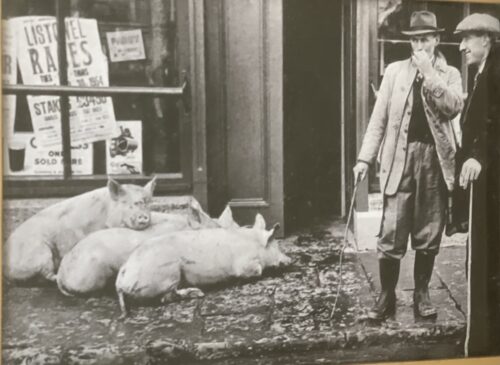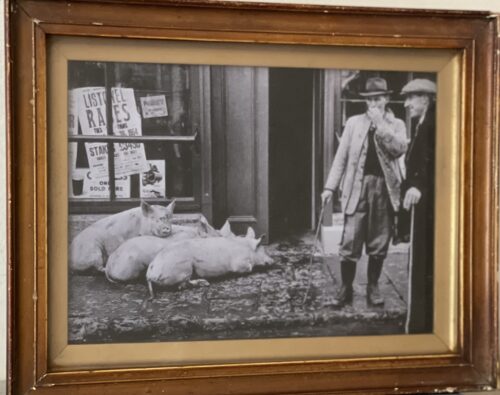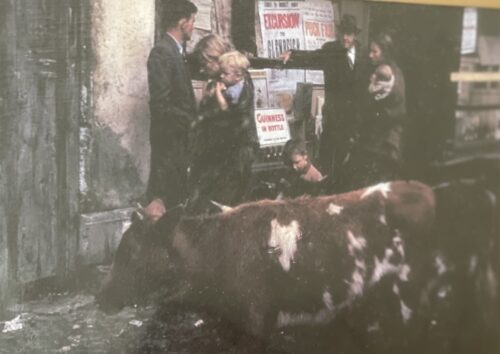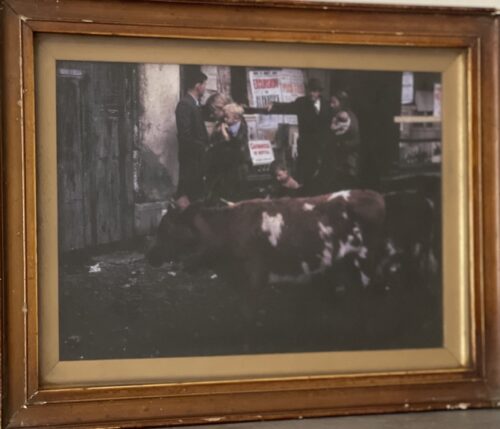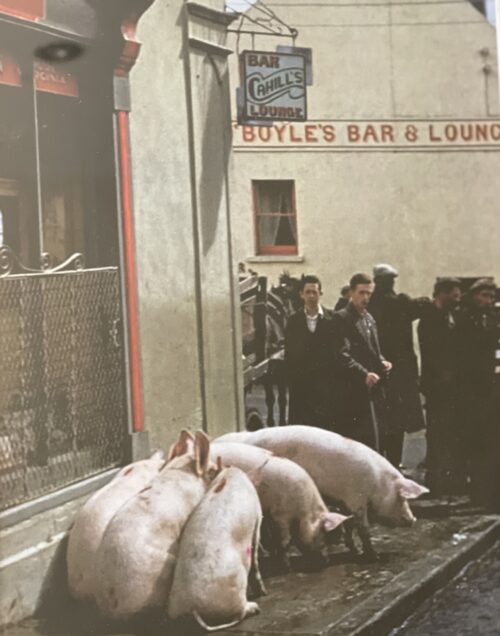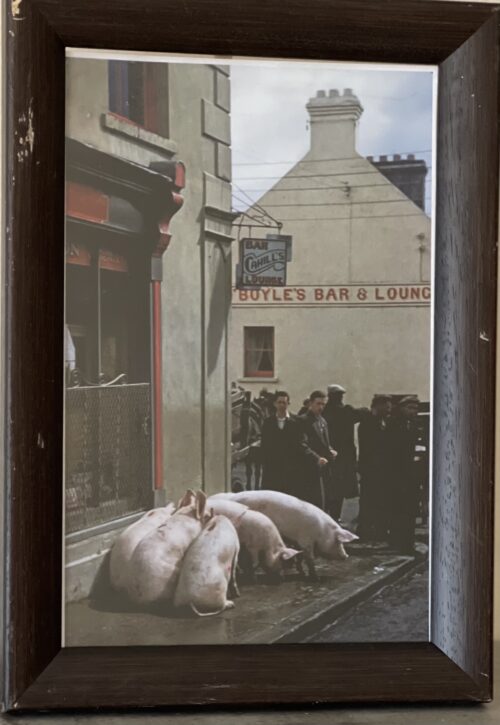Brilliant print capturing some of Micheal "Ó'Muircheartaigh's most famous moments of commentary over the decades.Superb piece for the GAA enthusiast and celebrating one of our greatest ever broadcasters.
Origins : Banagher Co Offaly Dimensions: 52cm x 40cm
Micheal Ó Muircheartaigh (born 20 August 1930)
[1] is an Irish
Gaelic games commentator for the Irish national radio and television,
RTÉ. In a career that has spanned six decades he has come to be regarded as the "voice of Gaelic games." His prolific career has earned him a place in
Guinness World Records.
Early life
Mícheál Ó Muircheartaigh was born in Dún Síon just outside
Dingle,
County Kerry in 1930.
Ó Muircheartaigh grew up on the family farm and was educated locally in Dingle. In September 1945 he began studying at Coláiste Íosagáin in
Baile Bhúirne in the
County Cork Gaeltacht where he was in training to be a teacher. It was at this all-
Irish school that his name changed from Michael Moriarty to the Irish version Mícheál Ó Muircheartaigh. In September 1948 he began the final year of his teacher training at
St Patrick's College of Education in
Drumcondra,
Dublin.
Broadcasting career
In early March 1949 Ó Muircheartaigh, along with ten other students from the college, and several from other colleges, did a test commentary on a
hurling game at
Croke Park. Each student had to commentate for five minutes in Irish and the most successful would be selected for further commentary work. Ó Muircheartaigh had never seen a game of hurling before in his life. But he knew that those adjudicators judging his commentary were not able to see the game:
'Twas a new game to me. But I knew one person. He was in goal for UCD and his name was Tadhg Hurley. He went to school in Dingle and he had hurling because his father was a bank manager and had spent time in Tipperary or Cork. The moment my minute started, he was saving a fantastic shot. And he cleared it away out, I can still see it, out over the sideline, Cusack Stand side of the field, eighty yards out. But it was deflected out by a member of the opposition. The adjudicators couldn't see that that didn't happen. Who was called out to take the line-ball? The only person I knew, Tadhg Hurley. And he took a beautiful line-ball - Christy Ring never took better. He landed it down in front of the Railway goal, there was a dreadful foul on the full-forward, and there was a penalty. And who was called up to take the penalty? Tadhg Hurley. 'Twas the best individual display ever seen in Croke Park. It took him at least a minute to come from the Canal goal up. And while he was coming up I spoke about his brother Bob, who was in Donal's class, and his sister who used to come out to Dún Síon strand during the summer. So eventually he took the penalty. I've seen DJ Carey, I've seen Nicky Rackard, I've seen Christy Ring. None of them could ever equal the display he gave that day... Sin mar a thosaigh sé!
Ó Muircheartaigh was the one selected and his first assignment was to provide an all-Irish commentary on the 1949
Railway Cup final on
St. Patrick's Day.
He graduated from St. Patrick's College a little later and also completed a
Bachelor of Arts degree from
University College Dublin. He taught economics, accountancy and Irish in both primary and secondary schools throughout
Dublin, the majority of which were run by the
Christian Brothers. He continued teaching up until the 1980s, when he became a full-time broadcaster with
Raidió Teilifís Éireann.
For the early part of his broadcasting career Ó Muircheartaigh commentated on
Minor GAA matches, in the
Irish language. He also replaced the legendary Micheál O'Hehir when he was not available to commentate. Eventually when O'Hehir was forced to retire in the mid-1980s Ó Muircheartaigh took over as the station's premier radio commentator. He developed his own inimitable style of commentary and his accent is unmistakably that of a native Irish speaker. He is a true lover of
Gaelic Athletic Association and it is reflected in the enthusiasm he brings to matches. His unusual turn of phrase has made him a much loved broadcaster and often imitated character. He has become particularly famous in Ireland for his unusual turns of phrase in the heat of the moment while commentating. Today he commentates on
RTÉ Radio 1. In 2004 he published his autobiography, 'From Dún Sion to
Croke Park'.
Ó Muircheartaigh's commentaries for
RTÉ Radio 1's
Sunday Sport show won him a
Jacob's Award in 1992. He was also the Parade Grand Marshal for the 2007 St. Patrick's Festival, having been given the honour by the chairman of the Festival in recognition and appreciation of his unique contribution to Irish culture.
He will be the Parade Grand Marshal for the 2011 St. Patrick's Parade in Toronto, Ontario, Canada, also in recognition and appreciation of his unique contribution to Irish culture.
On 16 September 2010 he announced his retirement from broadcasting.
The last All-Ireland he commentated on was the
2010 All-Ireland Senior Football Championship Final on 19 September 2010.
On 29 October 2010 it was announced that the 2nd International Rules test at
Croke Park would be Ó Muircheartaigh's final broadcast as commentator on
RTÉ Radio 1. On 30 October 2010 Micheál commentated his final commentary alongside RTÉ's pundit and former
Meath footballer
Bernard Flynn.
He is contracted to officiate at the
2011–12 Volvo Ocean Race finish in Galway when he will commentate on the finish to the round the world race, to give it a uniquely Irish conclusion. Sailing has been a long time hobby of O Muircheartaigh.
Ó Muircheartaigh writes a weekly sports column for
Foinse, the Irish-language newspaper free with the
Irish Independent each Wednesday.
Ó Muircheartaigh was invited to read out a piece in Irish and in English at an event called "Laochra" in Croke Park on 24 April 2016 to commemorate the 100th anniversary of the Easter Rising.
Other media
He is the main commentator in the 2005 video game
Gaelic Games: Football for the
PlayStation 2 and its 2007
sequel
He was featured in the video "Mícheál Ó Muircheartaigh - Making a ham sandwich" which was posted on a Reddit forum, noting his "relaxing" voice.
Honours
Mícheál was awarded an honorary doctorate by
NUI Galway in 1999 for his lifetime service to broadcasting.
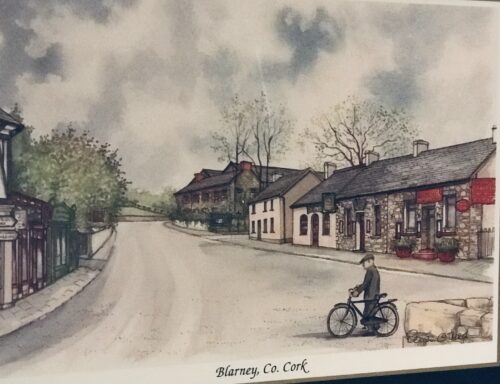
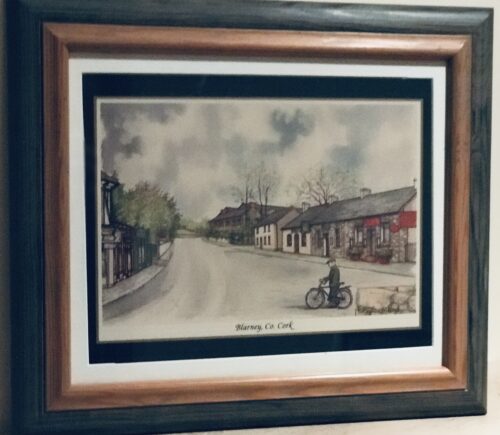 Beautiful depiction of Blarney Co Cork. These beautiful quaint scenes from six individual towns were originally table and have been superbly mounted and framed to create a memorable souvenir collection.Originally painted by talented local artist Roisin O Shea,the prints depict everyday scenes of streetlife in Killarney,Kilkenny,Blarney,Galway,Kinsale and Youghal. Lahinch Co Clare 33cm x 39cm
Beautiful depiction of Blarney Co Cork. These beautiful quaint scenes from six individual towns were originally table and have been superbly mounted and framed to create a memorable souvenir collection.Originally painted by talented local artist Roisin O Shea,the prints depict everyday scenes of streetlife in Killarney,Kilkenny,Blarney,Galway,Kinsale and Youghal. Lahinch Co Clare 33cm x 39cm
 Beautiful depiction of Galway City. These beautiful quaint scenes from six individual towns were originally table and have been superbly mounted and framed to create a memorable souvenir collection.Originally painted by talented local artist Roisin O Shea,the prints depict everyday scenes of streetlife in Killarney,Kilkenny,Blarney,Galway,Kinsale and Youghal. Lahinch Co Clare 33cm x 39cm
Beautiful depiction of Galway City. These beautiful quaint scenes from six individual towns were originally table and have been superbly mounted and framed to create a memorable souvenir collection.Originally painted by talented local artist Roisin O Shea,the prints depict everyday scenes of streetlife in Killarney,Kilkenny,Blarney,Galway,Kinsale and Youghal. Lahinch Co Clare 33cm x 39cm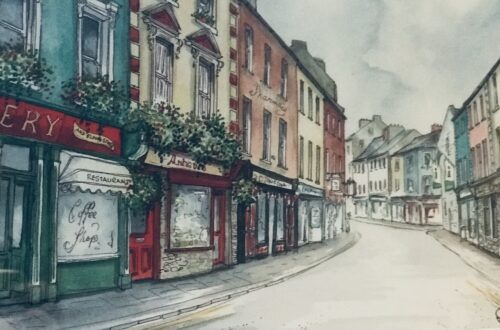
 Beautiful depiction of Kilkenny City. These beautiful quaint scenes from six individual towns were originally table and have been superbly mounted and framed to create a memorable souvenir collection.Originally painted by talented local artist Roisin O Shea,the prints depict everyday scenes of streetlife in Killarney,Kilkenny,Blarney,Galway,Kinsale and Youghal. Lahinch Co Clare 33cm x 39cm
Beautiful depiction of Kilkenny City. These beautiful quaint scenes from six individual towns were originally table and have been superbly mounted and framed to create a memorable souvenir collection.Originally painted by talented local artist Roisin O Shea,the prints depict everyday scenes of streetlife in Killarney,Kilkenny,Blarney,Galway,Kinsale and Youghal. Lahinch Co Clare 33cm x 39cm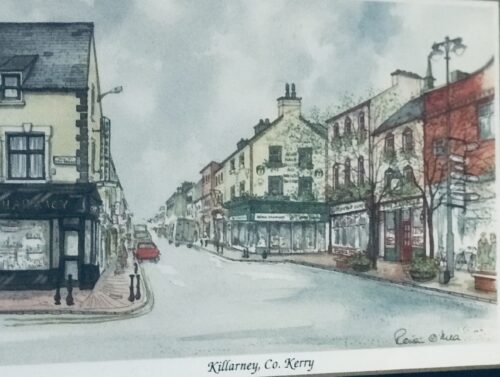
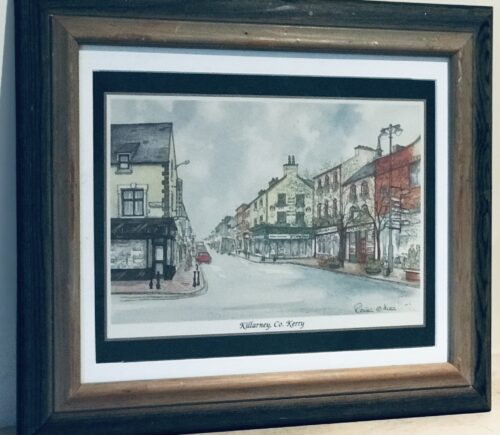 Beautiful depiction of Killarney Co Kerry. These beautiful quaint scenes from six individual towns were originally table and have been superbly mounted and framed to create a memorable souvenir collection.Originally painted by talented local artist Roisin O Shea,the prints depict everyday scenes of streetlife in Killarney,Kilkenny,Blarney,Galway,Kinsale and Youghal. Lahinch Co Clare 33cm x 39cm
Beautiful depiction of Killarney Co Kerry. These beautiful quaint scenes from six individual towns were originally table and have been superbly mounted and framed to create a memorable souvenir collection.Originally painted by talented local artist Roisin O Shea,the prints depict everyday scenes of streetlife in Killarney,Kilkenny,Blarney,Galway,Kinsale and Youghal. Lahinch Co Clare 33cm x 39cm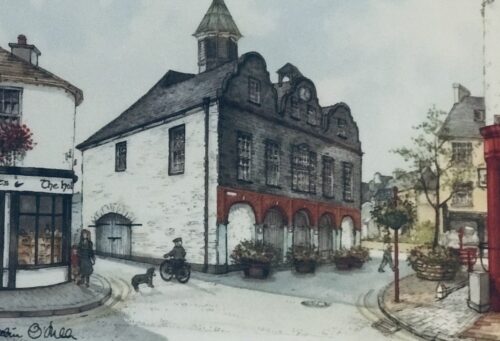
 Beautiful depiction of Kinsale Co Cork These beautiful quaint scenes from six individual towns were originally table and have been superbly mounted and framed to create a memorable souvenir collection.Originally painted by talented local artist Roisin O Shea,the prints depict everyday scenes of streetlife in Killarney,Kilkenny,Blarney,Galway,Kinsale and Youghal. Lahinch Co Clare 33cm x 39cm
Beautiful depiction of Kinsale Co Cork These beautiful quaint scenes from six individual towns were originally table and have been superbly mounted and framed to create a memorable souvenir collection.Originally painted by talented local artist Roisin O Shea,the prints depict everyday scenes of streetlife in Killarney,Kilkenny,Blarney,Galway,Kinsale and Youghal. Lahinch Co Clare 33cm x 39cm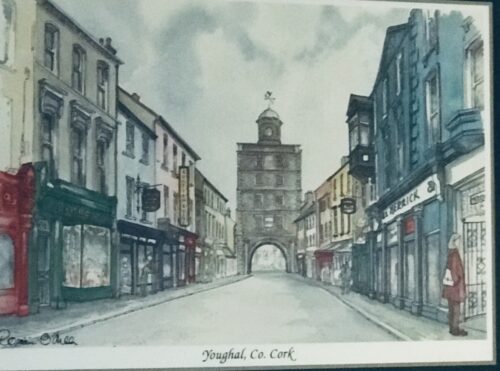
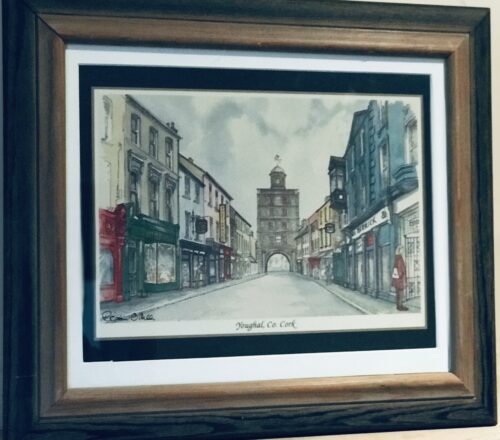 Beautiful depiction of Youghal Co Cork. These beautiful quaint scenes from six individual towns were originally table and have been superbly mounted and framed to create a memorable souvenir collection.Originally painted by talented local artist Roisin O Shea,the prints depict everyday scenes of streetlife in Killarney,Kilkenny,Blarney,Galway,Kinsale and Youghal. Lahinch Co Clare 33cm x 39cm
Beautiful depiction of Youghal Co Cork. These beautiful quaint scenes from six individual towns were originally table and have been superbly mounted and framed to create a memorable souvenir collection.Originally painted by talented local artist Roisin O Shea,the prints depict everyday scenes of streetlife in Killarney,Kilkenny,Blarney,Galway,Kinsale and Youghal. Lahinch Co Clare 33cm x 39cm
 Beautiful depiction of Youghal Co Cork. These beautiful quaint scenes from six individual towns were originally table and have been superbly mounted and framed to create a memorable souvenir collection.Originally painted by talented local artist Roisin O Shea,the prints depict everyday scenes of streetlife in Killarney,Kilkenny,Blarney,Galway,Kinsale and Youghal. Lahinch Co Clare 33cm x 39cm
Beautiful depiction of Youghal Co Cork. These beautiful quaint scenes from six individual towns were originally table and have been superbly mounted and framed to create a memorable souvenir collection.Originally painted by talented local artist Roisin O Shea,the prints depict everyday scenes of streetlife in Killarney,Kilkenny,Blarney,Galway,Kinsale and Youghal. Lahinch Co Clare 33cm x 39cm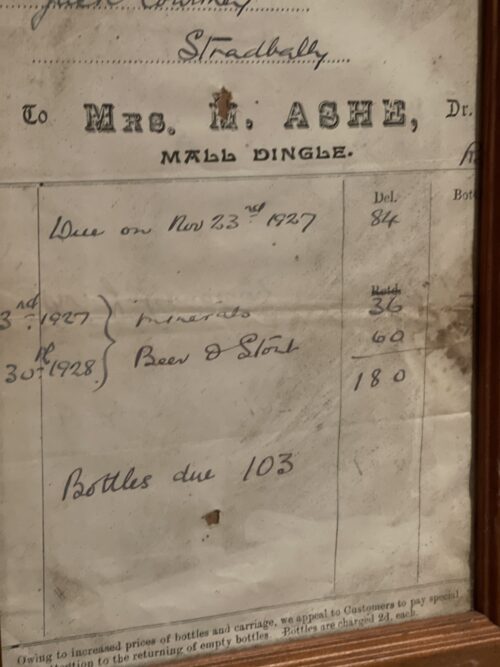
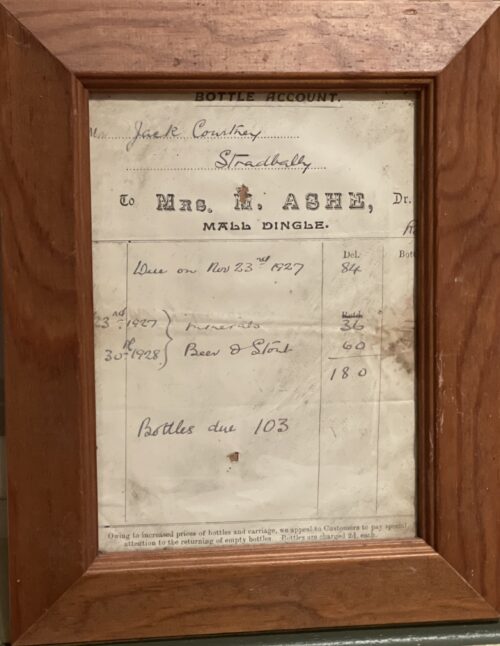 28cm x 22cm Fascinating piece of ephemera from 1928 as Mrs Ashe Mall Dingle issued a bottle account statement of affairs to a publican customer,Jack Courtney Castlegregory Co Kerry. "The Washington Bar, more commonly known as Gene Mackin’s, was situated next door to a newspaper shop on the Falls Road opposite the Dunville Park in West Belfast. The Munster and Leinster Bank was close by. Gene and his sister Margaret were the proprietors of the bar and shop respectively. They lived on the premises and were highly thought of by their customers and the local community in general. The bar was a dark old fashioned male dominated establishment, women were not encouraged and there were no female toilet facilities anyway. Both Gene Mackin and Bobby his main barman in the early sixties were adept at sign language and this encouraged a wide spread of customers from all parts of the road. The bar was bombed in the early years of the troubles and the Mackins moved to the suburbs and slowly faded away from public life. At the start of the Swinging Sixties Gene Mackin’s Washington bar was most likely to have been the very last watering hole on the Falls Road that bottled their own Guinness. In a shed in the backyard of the bar the two day process began with the washing of the hundreds of bottles that had been carefully stacked in a very large metal tub over the previous weeks. Cold tap water was used but occasionally if the weather warranted a kettle of boiling water as added. The soaking allowed the old labels to be easily removed as a simple flour and water paste had been the original adhesive. A bottle washing brush with stiff bristles was the only tool required and the bar had an adequate supply of those. The washed bottles were left to drain upside down on a wooden board in which holes had been bored to accommodate the bottle neck. When dry they were placed on large wooden trays in readiness for the next day. The Guinness came in a large metal barrel or firkin. A tap had to be inserted into the bung hole to allow for the pouring of the liquid and this was always challenging as it was quite possible to get a soaking if it wasn’t processed correctly. It was usually accomplished with a degree of dexterity and of course judicial force. The weight of the barrel meant that it couldn’t be raised to an ideal working height so the bottler had to sit on a small stool. With practice the filling of the bottles was fast and rote; the tap was left open and using two hands, one for the empty bottle to fill and the other to carefully place the filled bottle on the large tray.
28cm x 22cm Fascinating piece of ephemera from 1928 as Mrs Ashe Mall Dingle issued a bottle account statement of affairs to a publican customer,Jack Courtney Castlegregory Co Kerry. "The Washington Bar, more commonly known as Gene Mackin’s, was situated next door to a newspaper shop on the Falls Road opposite the Dunville Park in West Belfast. The Munster and Leinster Bank was close by. Gene and his sister Margaret were the proprietors of the bar and shop respectively. They lived on the premises and were highly thought of by their customers and the local community in general. The bar was a dark old fashioned male dominated establishment, women were not encouraged and there were no female toilet facilities anyway. Both Gene Mackin and Bobby his main barman in the early sixties were adept at sign language and this encouraged a wide spread of customers from all parts of the road. The bar was bombed in the early years of the troubles and the Mackins moved to the suburbs and slowly faded away from public life. At the start of the Swinging Sixties Gene Mackin’s Washington bar was most likely to have been the very last watering hole on the Falls Road that bottled their own Guinness. In a shed in the backyard of the bar the two day process began with the washing of the hundreds of bottles that had been carefully stacked in a very large metal tub over the previous weeks. Cold tap water was used but occasionally if the weather warranted a kettle of boiling water as added. The soaking allowed the old labels to be easily removed as a simple flour and water paste had been the original adhesive. A bottle washing brush with stiff bristles was the only tool required and the bar had an adequate supply of those. The washed bottles were left to drain upside down on a wooden board in which holes had been bored to accommodate the bottle neck. When dry they were placed on large wooden trays in readiness for the next day. The Guinness came in a large metal barrel or firkin. A tap had to be inserted into the bung hole to allow for the pouring of the liquid and this was always challenging as it was quite possible to get a soaking if it wasn’t processed correctly. It was usually accomplished with a degree of dexterity and of course judicial force. The weight of the barrel meant that it couldn’t be raised to an ideal working height so the bottler had to sit on a small stool. With practice the filling of the bottles was fast and rote; the tap was left open and using two hands, one for the empty bottle to fill and the other to carefully place the filled bottle on the large tray. The bottle caps were the classic tin top of metal with a cork cushion and were put on using a press made especially for this task. A magnet held the top in place over the bottle and a lever was pulled forcing the cap onto the neck and thus sealing the bottle and it’s precious contents. Care had to be taken doing this because too heavy a hand could easily result in the bottle shattering.
All that now remained was the sticking on of the labels which told of the bottle contents and the name of the bar. Using a paste of flour and water and with a little practice this was accomplished quite easily. After a few days settling the new bottles of Guinness were brought into the bar to be sold."
The bottle caps were the classic tin top of metal with a cork cushion and were put on using a press made especially for this task. A magnet held the top in place over the bottle and a lever was pulled forcing the cap onto the neck and thus sealing the bottle and it’s precious contents. Care had to be taken doing this because too heavy a hand could easily result in the bottle shattering.
All that now remained was the sticking on of the labels which told of the bottle contents and the name of the bar. Using a paste of flour and water and with a little practice this was accomplished quite easily. After a few days settling the new bottles of Guinness were brought into the bar to be sold." 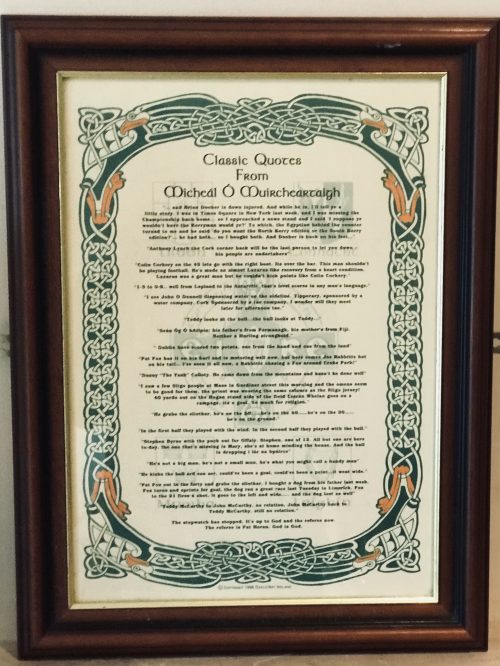 Brilliant print capturing some of Micheal "Ó'Muircheartaigh's most famous moments of commentary over the decades.Superb piece for the GAA enthusiast and celebrating one of our greatest ever broadcasters. Origins : Banagher Co Offaly Dimensions: 52cm x 40cm Micheal Ó Muircheartaigh (born 20 August 1930)[1] is an Irish Gaelic games commentator for the Irish national radio and television, RTÉ. In a career that has spanned six decades he has come to be regarded as the "voice of Gaelic games." His prolific career has earned him a place in Guinness World Records.
Brilliant print capturing some of Micheal "Ó'Muircheartaigh's most famous moments of commentary over the decades.Superb piece for the GAA enthusiast and celebrating one of our greatest ever broadcasters. Origins : Banagher Co Offaly Dimensions: 52cm x 40cm Micheal Ó Muircheartaigh (born 20 August 1930)[1] is an Irish Gaelic games commentator for the Irish national radio and television, RTÉ. In a career that has spanned six decades he has come to be regarded as the "voice of Gaelic games." His prolific career has earned him a place in Guinness World Records.
